"LET THERE BE LIGHT" Ministries
THE SANCTUARY AND TEMPLE OF GOD, Part 3 quotes
1) The Outer Court:
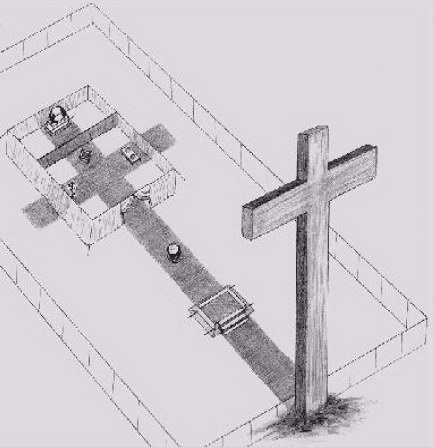
This Outer Court is described in Exodus 27:9-18 and 38:9-19, and its circumference was a perfect rectangle of “an hundred cubits long”, and a cubit is approximately 1 ½ feet – so it was about 150 feet long on both the North and South sides, was “fifty cubits” or 75 feet wide on both the East and West sides, and was “five cubits” or 7 ½ feet high all around. All of this area was completely fenced in by hanging curtains of fine twined linen that was white in color, which fully shielded from view everything that was inside of this court. This white linen curtain was held up with silver hooks suspended on silver fillets or rails which were securely attached to the silver chapiters or top caps on each of the 60 brass pillars that were evenly spaced every 7 ½ feet apart and whose bases were set in sockets of brass.
In the middle of the East end of this white linen fencing was a gate way of hanging curtains about 45 feet wide. These fine twined linen curtains were not white in color, but were “of blue, and purple, and scarlet”, and these provided the only entrance into this Outer Court and thus the only way to eventually gain access to the Sanctuary. This meant that everyone who desired to enter into this Outer Court and possibly later into the Sanctuary itself had to first pass through this colored curtain.
After passing through this colored curtain and coming into this Outer Court was seen a huge Brazen Altar of burnt offering, a Brazen Laver or wash basin, as well as the Sanctuary itself.
The Brazen Altar
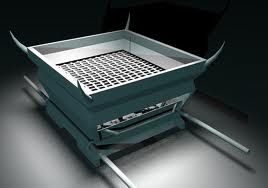
The Brazen Altar of burnt offering (see Exodus 27:1-8) was a perfect square of “five cubits” or 7 ½ feet long and wide, and “three cubits” or 4 ½ feet high. It was made of “boards” “of shittim wood” overlaid with brass, and had a “grate of network of brass” to keep the sacrifices of the innocent substitute victims above the wood fire kindled beneath. It also was built with four “horns” upon the “four corners thereof”, as well as “four brasen rings in the four corners thereof” that would have two “staves of shittim wood” overlaid with brass with one inserted into each of the two rings on either side when it needed to be carried. This Brazen Altar was placed a short distance past this entrance curtain, which meant that this was the first object seen when entering into this Outer Court.
The Brazen Laver
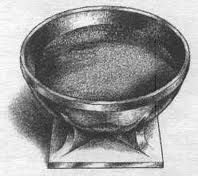
The Brazen Laver or wash basin (see Exodus 30:17-21) was a large basin filled with water which was supported by and set upon a pedestal or stand. This Brass Laver was to wash away any contaminants from off the priests, and this was placed in the open space between the Brazen Altar and the Sanctuary. This meant that after passing the Brazen Altar one then had to then pass this wash basin before they could come to the Sanctuary itself which was situated at the farther west portion of this Outer Court.
2) This white linen curtain fencing that completely surrounded the Outer Court and shielded from view everything that was within it, represents the pure, spotless white robe of the righteousness of Christ! All who entered within this Outer Court were completely covered within this white linen curtain fencing until none of themselves could be seen, and thus Christ’s robe of righteousness completely and fully covers us so that none of self can be seen.
What resented the entrance curtain of linen colored blue, purple and scarlet? The color blue symbolizes obedience (Numbers 15:38-40). The color scarlet or dark red symbolizes blood and sacrifice and cleansing from sin (Leviticus 14:4-7; Isaiah 1:18; Hebrews 9:19-22), and the color purple, which is made up of a combination of blue and red, is the color of royalty (Judges 8:26; Mark 15:17-18). So purple symbolizes the combination of obedience and sacrifice which is worthy of royalty. This curtain represents Christ’s entire royal life of obedience combined with self sacrifice every moment of every day that kept His human character absolutely perfect and spotless and righteous, and then He voluntarily offered up His innocent life and spilled His blood to become a Substitute victim in order to save mankind from death and destruction. And all who entered into this Outer Court had to first pass through this curtain, and without doing so, they could not enter in.
The Altar of Sacrifice represents Christ’s atoning sacrifice and death on the cross as an innocent Substitute victim to spare the guilty, and the benefits of this atoning sacrifice is freely provided to all those who accept and embrace Christ as their Saviour. Also, all who wanted to go to the Sanctuary had to first pass this Altar.
The Brazen Laver or wash basin represents being washed and cleansed from all contaminants of unrighteousness by Christ who is the real Water of Life. And all who wanted to go to the Sanctuary had to first pass this Laver.
3) The Sanctuary:
The Sanctuary itself is described in Exodus 26:1-37, and was built as a perfect rectangle made up of “twenty boards” “of shittim wood” on the North and South sides, and “eight boards” on the West side. Now each board was plated with pure gold and was “ten cubits” or about 15 feet long and “a cubit and a half” or about 2 1/4 feet wide. These golden boards were then placed upright and aligned together side by side, supported beneath by “two sockets” of silver under each board, and secured above by “bars of shittim wood” overlaid with pure gold. This meant that the Sanctuary was about 45 feet long, 18 feet wide, and 15 feet high, being twice as high as the Outer Court fencing and thus easily seen above it.
On the East end of this Sanctuary there were not boards, but there were placed “five pillars of shittim wood” overlaid with pure gold and evenly spaced, that were securely resting upon five sockets of brass. Upon these pillars were hung a fine twined linen curtain or veil “of blue, and purple, and scarlet” that was supported with pure golden hooks. This curtain or veil served as an entrance or door into this Sanctuary.
All along the outside of the boards of the Sanctuary was placed a series of fine twined linen curtains or coverings of “blue, and purple, and scarlet: with cherubims of cunning work” embroidered on them, and then on the outside of this was placed several layers of curtains or coverings of “goats hair”. The roof of this sanctuary was composed “of rams’ skins dyed red next to the Sanctuary itself, and then over this was placed a covering of badgers’ skins” that would shed away any rain.
Now towards the West end of this Sanctuary there were set “four pillars of shittim wood overlaid with gold” and evenly spaced, that were securely resting upon four sockets of silver. Upon these pillars were hung a fine twined linen curtain or veil “of blue, and purple, and scarlet” that had “cherubims” or angels embroidered into it which was supported with pure golden hooks. This curtain or veil divided this Sanctuary into two different apartments or rooms called the Holy Place and the Most Holy Place (see Exodus 26:33; 1 Kings 6:16-17, 8:6-10; Hebrews 9:2-3), and this curtain also served as an entrance or door into this Sanctuary.
4) The First Apartment:
After passing through this colored linen door or curtain or veil you entered into the First Apartment or the Holy Place of the Sanctuary. Once inside there stood a golden Table of Showbread on the North or right side, and a golden Candlestick on the South or left side (Exodus 26:35). And directly West before the inner veil which separated the Holy from the Most Holy Place was a golden Altar of Incense (Exodus 30:6).
The Table of Showbread
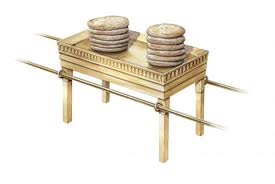
The Table of Showbread (see Exodus 25:23-30, 40:22-23) was “two cubits” or about 3 feet long, and “a cubit” or about 1 ½ feet wide, and “a cubit and a half” or about 2 1/4 feet high. It was made of “shittim wood” overlaid with pure gold, and had a crown of pure solid gold “of an hand breadth” or about 6 inches high as a border all around the top edge. It was also made with “four rings of gold” placed “in the four corners” on one of each of its “four feet” or legs, and would have two “staves of shittim wood” overlaid with gold with one inserted into the two rings on either side when it needed to be carried.
On this Table of Showbread were placed “twelve cakes” of fresh baked “hot bread” made from unleavened “fine flour” (Leviticus 24:5). These 12 cakes or loaves of bread were considered holy and not common (1 Samuel 21:3-6). They were placed upon this Table “in two rows” of “six” bread each (Leviticus 24:6), and were replaced every Sabbath with new fresh hot bread (Leviticus 24:8; 1 Chronicles 9:32). This Showbread was always to be placed continually before the Lord on this Table, and was never allowed to be without it (Exodus 25:30; 2 Chronicles 2:4) – even when the Table of Showbread was being moved (Numbers 4:7)!
The Candlestick
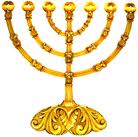
The Candlestick (see Exodus 25:31-40, 40:24-25) was made of pure solid gold with a central “shaft” which then had “three branches” coming out on either side of it, thus making a total of seven different stocks. On the top of each of these seven golden stocks were added “bowls made like unto almonds”, that were then filled with pure olive oil (Leviticus 24:2).
At the pointed end of each of these seven golden almond shaped bowls filled with pure olive oil was where it was lit with fire, and then each functioned like an oil lamp. These “seven lamps” were to “burn continually” by day and by night and were never to go out while within the Sanctuary, since they provided the only light which illuminated all of this First Apartment (Leviticus 24:2) by reflecting off of all the pure gold covered walls. These bowls were large enough to hold a sufficient amount of oil to keep their lamp burning brightly for some time, but every evening and morning whatever oil had been used up was replaced (Leviticus 24:3), so that there would be no chance that any of these seven lamps could go out.
The Altar of Incense
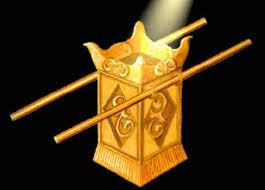
The Altar of Incense (see Exodus 30:1-10, 34-38, 40:5, 26-27) was a perfect square of “a cubit” or 1 ½ feet long and wide, and “two cubits” or 3 feet high. It was made “of shittim wood” overlaid with pure gold, and had a crown of pure solid gold as a border all around the top edge. It also was built with four “horns” upon its 4 corners, as well as just “two golden rings” placed in the middle between the 4 corners on two opposite sides that would have two “staves of shittim wood” overlaid with pure gold with one inserted into each ring when it needed to be carried. This golden Altar of Incense was placed directly in front of the inner veil into the Most Holy Place.
Upon this Altar of Incense were kept live “coals of fire” (Leviticus 16:12; Numbers 16:46) which were replenished when necessary, and then upon these live coals was burned incense “every morning” and evening on a “perpetual” and continual basis. The type of incense used was composed of “sweet spices and frankincense...tempered together” and ground small, which when burned produced a “cloud” of a very pleasant and sweet smelling fragrance (Leviticus 16:13).
5) What represents this curtain or veil into the First Apartment? We discovered earlier that the linen curtain or entrance door into the Outer Court was colored blue, purple and scarlet, and the same with this linen curtain or door or veil into the Sanctuary. And these blue, purple and scarlet colors represented Christ’s entire life of obedience combined with self sacrifice every moment of every day that kept His human character absolutely perfect and spotless and righteous, and then He voluntarily offered up His innocent royal life and spilt His blood as a substitute Victim to save mankind from death and destruction. This meant that all who entered into this Holy Place of the Sanctuary had to first pass through another curtain that was colored the exact same way, and without doing so, they could not enter in.
The golden Table of Showbread with its 12 loaves of fresh bread stacked into two piles of 6 each symbolized the place where the Bread of Life which is the Word of God could be found, and the meaning of the two stacks of this bread symbolized the Old and the New Testaments of God’s Word! The meaning of why this holy bread was replaced hot and fresh every Sabbath day was to teach us that on each Sabbath there is available the possibility of gaining a new and fresh experience in learning and understanding more of the divine truths of God’s word, and since there was more than just one loaf of bread, then all who will seek to gain this fresh learning will obtain it. Now all who entered within this Holy Place of the First Apartment on their way towards the Most Holy Place had to pass by this Table.
The golden Candlestick with its seven lamps kept continuously burning through a constant supply of olive oil, which provided light for this First Apartment symbolizes the Holy Spirit who supplies a constant source of grace and enlightenment to each of God’s followers so that all darkness can be dispelled in their own hearts, and then they can let their unobstructed light shine to dispel the darkness in other hearts.
“And said unto me, What seest thou? And I said, I have looked, and behold a candlestick all of gold, with a bowl upon the top of it, and his seven lamps thereon, and seven pipes to the seven lamps, which are upon the top thereof: And two olive trees by it, one upon the right side of the bowl, and the other upon the left side thereof. So I answered and spake to the angel that talked with me, saying, What are these, my lord? Then the angel that talked with me answered and said unto me, Knowest thou not what these be? And I said, No, my lord. Then he answered and spake unto me, saying, This is the word of the LORD unto Zerubbabel, saying, Not by might, nor by power, but by my spirit, saith the LORD of hosts....Then answered I, and said unto him, What are these two olive trees upon the right side of the candlestick and upon the left side thereof? And I answered again, and said unto him, What be these two olive branches which through the two golden pipes empty the golden oil out of themselves? And he answered me and said, Knowest thou not what these be? And I said, No, my lord. Then said he, These are the two anointed ones, that stand by the Lord of the whole earth.” Zechariah 4:2-6, 11-14.
So there are two olive trees standing near the Candlestick, and from these two trees are two olive branches supplying a constant source of olive oil through two golden pipes connected to a golden bowl which then carries through pipes a sufficient amount of olive oil directly to each of the seven lamps on the golden Candlestick to keep them constantly burning. These two olive trees symbolize the Old and the New Testaments; the olive oil symbolizes the Holy Spirit; the pipes represent a direct and unbroken connection. Now the bowl symbolizes the heart of each follower of God, who are to allow the light of truth to dispel all darkness in their own heart, and then they are to continuously shine this light out to dispel darkness in those all around them.
This means that the Holy Spirit is directly connected with the Word of God, and by partaking of this Bread of Life, the Holy Spirit would be directly and personally connected with that individual reader in order to provide them with a sufficient amount of grace, wisdom, discernment and enlightenment. This would then fully light up their own minds and dispel any darkness and errors in their own understanding, and then the Holy Spirit encourages and leads and strengthens them to follow the truths they have read, and to let their light clearly shine forth to others.
The golden Altar of Incense from which a continuous supply of sweet incense burned upon the live coals of fire, which then provided a cloud of fragrance that daily ascended up before God and which pleased Him as He smelled it represents the heart of each follower of God, and as burning coals of fire were kept continuously burning upon it, so each heart must be kept continuously burning with the fire of love and devotion to God, as well as to one another, and they are not to allow their heart to ever grow cold.
The incense which was composed of various sweet spices and which was continuously placed and bestowed upon these coals of fire, symbolizes the various righteous merits of Jesus Christ which are freely placed and continuously bestowed upon us (Note: merits mean various excellent and worthy aspects of character or actions). As these righteous merits of Christ are bestowed upon us and utilized in our lives, then our prayers, our acts of devotion to and worship of God, our unselfish actions in performing God’s will in our own lives as well as in good works for others, are each made acceptable and pleasing to God since all these have the right and proper fragrance and smell.
This particular understanding is revealed in Revelation 8:3-4:
“And another angel came and stood at the altar, having a golden censer; and there was given unto him much incense, that he should offer it with the prayers of all saints upon the golden altar which was before the throne. And the smoke of the incense, which came with the prayers of the saints, ascended up before God out of the angel’s hand.”
This means that without the righteous merits of Christ being placed and bestowed upon us, then none of our prayers, or devotion to and worship of God, or even our obedience to Him or good actions performed on others, would be acceptable to God because these would not have the right smell, but would instead have our own foreign smell connected with them.
6) The Second Apartment:
After passing through the four pillars of shittim wood overlaid with gold that supported the inner linen door or curtain or veil “of blue, and purple, and scarlet” that had “cherubims” or angels embroidered into it, you would enter into the Second Apartment or the Most Holy Place of the Sanctuary. Directly in front of you stood the Ark of the Covenant (see Exodus 25:10-22, 40:20-21; 1 Kings 8:9).
The Ark of the Covenant
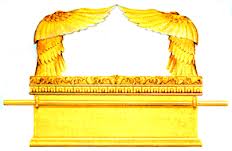
The Ark was “two cubits and a half” or about 3 3/4 feet long, and “a cubit and a half” or about 2 1/4 feet wide, and “a cubit and a half” or about 2 1/4 feet high. It was made of “shittim wood” overlaid with pure gold, was hollow inside like a box or chest, and it had a crown of pure solid gold as a border all around the top edge. It was also made with “four rings of gold” placed “in the four corners” that would have two “staves of shittim wood” overlaid with pure gold with one inserted into two rings on either side so it could be carried, and these staves “were not to be” removed from these rings.
Into this sacred box were placed the two tables of stone upon which were inscribed with God’s own finger His law of ten commandments. Above this sacred chest, and forming its cover or lid, was called the mercy seat. This mercy seat was made of pure solid gold, and was the exact same length and width as the chest, and so it fit precisely on top of this sacred chest and within that crown of gold all around the outside of the top edge which thus kept it from sliding. Now on both ends of this mercy seat itself, and not on either end of the mercy seat like I mentioned last Sabbath, were placed two cherubim angels made of solid gold. Their wings were to “stretch forth...on high, covering the mercy seat with their wings, and their faces shall look one to another; toward the mercy seat”.
This design and arrangement – with the mercy seat below and the two angels on either of its sides with their wings stretched forth over the mercy seat – formed an open space in between. It was in this open space that the divine presence of the Lord God Michael was manifested in a cloud of glory. And it was only in this Second Apartment and from that open space on the Ark that the Lord God Michael Himself dwelt.
7) What represents this inner curtain or veil into the Most Holy Place? We already discovered that this curtain of blue, purple and scarlet represents Christ’s entire life of obedience combined with self sacrifice every moment of every day that kept His human character absolutely perfect and spotless and righteous, and then He voluntarily offered up His innocent royal life and spilt His blood as a Substitute victim to save mankind from death and destruction. But this particular curtain had the added aspect of angels embroidered into it. This further symbolized all the angels of God who reside in His presence and wait to do His bidding, especially in being sent to aid and minister to each of God’s followers on the earth (Hebrews 1:7, 14). And all who entered into this Most Holy Place had to first pass through this third colored inner veil or curtain, and without doing so, they could not enter in.
What represents this Ark of the Covenant? The Lord God Michael dwelt above this mercy seat that was situated directly above His 10 commandment law. This was purposely arranged this way to teach that when any became guilty of breaking God's law and committing sin, then all they had to do was to look up and they could really obtain mercy and forgiveness from God Himself without being destroyed. Also, this was the only place where one could directly communicate and commune with God Himself, and He with them. So without going through each of the various symbolic steps in this Sanctuary process in order to reach this place, then no one could be able to directly come into the presence of God and communicate and commune with Him, and thus they would be lost.
8) What represents all of the gold used in this Sanctuary? It was only to be pure gold, which meant that it had to be refined to the highest possible degree of purity. This refining process involved great heat, time and watchful care in order to remove away all of the dross and worthless material once connected with it, and then leave behind just pure gold.
This symbolizes that through the plan of salvation God will continue to carefully refine and purge from us through fiery trials all the dross and worthless material, such as sin and selfishness, in order to leave behind just the pure gold of a righteous character (Zechariah 13:9; Malachi 3:3-4). And this process will indeed take place if we will just allow God to work in us to will and to do His good pleasure, and thus make both men and women “more valuable than the golden wedge of Ophir” (Isaiah 13:12).
What represents all of the silver used in this Sanctuary? It was only to be pure silver, which also had to be refined to the highest possible degree. This refining process also involved great heat, time and watchful care in order to remove away all of the dross and worthless material once connected with it, and then leave behind just pure silver.
This also symbolizes that through the plan of salvation God will continue to carefully refine and purify from our characters all worthless material if we allow just Him too, until all that will remain is pure righteousness (Zechariah 13:9; Malachi 3:3-4). And this fiery process will continue if we just allow our Saviour to refine us, thus enabling both men and women to be able to “offer unto the Lord an offering in righteousness” (Malachi 3:3; Psalms 4:1-5).
What represents all the brass used in the Sanctuary? Brass is a combination of copper and zinc which is fused together under heat and pressure until it becomes one metal, which makes it much stronger and harder and more durable than copper alone. Brass is easy to mold into shape; will expand without breaking under pressure and then immediately reduces back to normal size once the pressure is removed; and is also resistant to corrosion. Brass also polishes up to a mirror- like reflective surface, and is more common than either silver or gold.
So this teaches us that like brass, we are not to try to serve and obey God in our own strength alone, but we are to be yoked and fused together with Christ until we become one in Christ and so much more stronger and harder and durable than we were alone. We are also to allow our characters to be molded into the proper shape by our God, and are not to give up our faith under any pressure no matter how severe – even though it feels like we are expanding to the point of bursting; nor are we to allow the various trials to warp or mar our characters, but we are to maintain our faith at all times and under all circumstances, knowing that once we victoriously pass this test things will come back to normal. We are also to resist all enticements to sin, and not allow our characters to become corroded, but irregardless of how common we may be in the walks of life or in the eyes of the world, we are still to allow ourselves to be polished by our God until we can perfectly reflect the beautiful image of our Saviour.
What represents all the shittim wood used in the Sanctuary? The Hebrew word for “shittim” is “shittah” which translates and means “wood of the acacia that has scourging thorns” (Strong’s Exhaustive Concordance, word #7848). So the only wood God specifically chose to use all throughout this Sanctuary was from the a tree which defends itself with sharp thorns that easily pierced and punctured the skin of any who happened to brush up against it or disturbed it, and which then caused intense pain to the unfortunate victim. But all these thorns were cut away, and then this wood was completely covered over with pure gold until none of the wood itself remained to be seen.
This thorny acacia wood symbolizes you and me while we are dead in trespasses and sins, are unconverted, and are ready to pierce, puncture and cause intense pain to anyone who happens to brush up against us and disturb self. But through this marvelous plan of salvation, God will cut away all these sharp thorns of self and thus remove all selfishness, and then He will completely cover us over with pure smooth gold if we just allow Him too, until none of self or selfishness remains to be seen in us, but instead only the precious gold of a sanctified righteous character!
What represented the rams’ skins dyed red which the entire Sanctuary was covered over with as a roof? The ram was a symbol of Christ becoming the Substitute sacrifice to save mankind from death – as was revealed to Abraham when he was about to sacrifice Isaac (see Genesis 22:10-13). So with these rams’ skins died red, this clearly symbolized that without the shedding of the blood of Christ, the plan of salvation could not take place; no one could have their sins forgiven or cleansed from unrighteousness; and thus no one could ever think of coming directly into God’s divine presence and being able to then communicate and communing with God, and thus no one would be able to escape being destroyed in their sins!
Why were there three curtains all colored the same blue, purple and scarlet, which were placed at the entrances into the three different important places of this Sanctuary? Since each colored curtain represented Christ’s entire life of obedience combined with self sacrifice every moment of every day which kept His human character absolutely perfect and spotless and righteous, and then He voluntarily offered up His innocent royal life and spilled His blood as a Substitute Victim in order to save mankind from death and destruction, then this showed that each process within this Sanctuary was only made possible because of Christ’s life of righteousness and His willing sacrifice. And for us having to enter into one of these colored curtains 3 different times shows that it is not enough to confess Christ and accept His precious gift of righteousness just one time at conversion, but we must continue to confess Him and continue to have His righteousness every step of the way. Salvation is not once saved always saved, but it is a continual process of growing in grace until we become that perfect man or woman in Christ!
9) “When I thought to know this [about why the wicked prosper without any thought of God or of consequence for their evil doings], it was too painful for me; Until I went into the sanctuary of God; then understood I their end.” Psalms 73:16-17.
Thus without following the process of being justified and then sanctified through the sacrifice, blood, merits and righteousness of Jesus Christ, you will not be saved. Truly, “He that hath the Son hath life; and he that hath not the Son of God hath not life” (1 John 5:12).